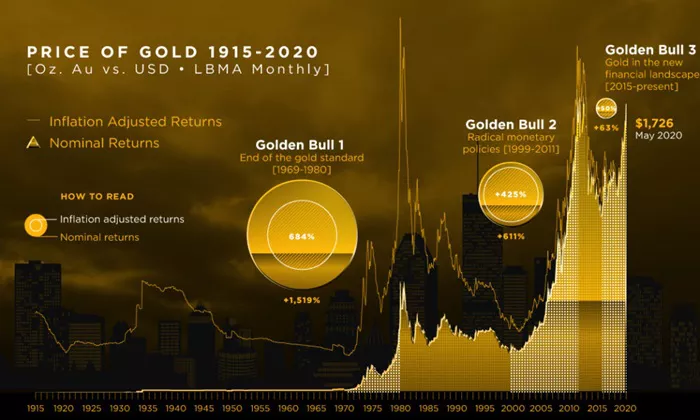Gold has long been a valuable asset and a barometer of economic stability. Understanding its historical price can provide insights into its role as an investment and its performance relative to other assets. This article delves into the price of gold from ten years ago, specifically in September 2014, exploring the factors that influenced its value and its significance in the broader economic context.
Overview of Gold Prices in September 2014
In September 2014, gold prices were experiencing a period of relative stability after a few years of significant volatility. The price of gold during this time ranged between approximately $1,200 and $1,250 per troy ounce. This range reflects the market’s reactions to a variety of economic indicators and geopolitical events.
Historical Context and Market Conditions
To understand the gold prices in September 2014, it’s essential to consider the broader economic and financial context of that period. Several key factors influenced the gold market at that time:
1. Post-Financial Crisis Environment
By 2014, the global economy was still recovering from the aftermath of the 2008 financial crisis. Central banks, particularly the U.S. Federal Reserve, had implemented various monetary policies to stabilize the economy, including low interest rates and quantitative easing. These measures had a significant impact on gold prices, as investors often turn to gold as a safe haven when economic uncertainty is high.
2. Strengthening U.S. Dollar
Throughout 2014, the U.S. dollar was gaining strength against other major currencies. A stronger dollar typically puts downward pressure on gold prices because gold is priced in dollars. When the dollar appreciates, gold becomes more expensive in other currencies, which can lead to decreased demand and lower prices.
See also: How Much Is 10 Karat Gold Worth?
3. Federal Reserve Policies
In 2014, the Federal Reserve was tapering its quantitative easing program, which had been in place since the financial crisis. The gradual reduction of asset purchases indicated a potential shift in U.S. monetary policy, influencing market expectations and impacting gold prices. Investors closely watched the Fed’s actions for clues about future economic conditions and their potential effects on gold.
4. Geopolitical Tensions
The geopolitical landscape also played a role in gold’s price movement. In September 2014, the world was dealing with various conflicts and uncertainties, including tensions in the Middle East and ongoing issues in Ukraine. Such geopolitical tensions often drive investors towards gold as a hedge against risk, contributing to fluctuations in its price.
Gold Price Trends Leading Up to September 2014
Examining the price trends leading up to September 2014 provides additional insights into the factors affecting gold prices:
Pre-2014 Trends
Prior to 2014, gold experienced significant price volatility. After peaking at over $1,900 per ounce in 2011, gold prices had been on a downward trajectory. By the end of 2013, gold prices had fallen significantly from their highs, settling around $1,200 to $1,300 per ounce. This decline was influenced by various factors, including improving economic conditions and reduced demand for gold as a safe-haven asset.
Gold’s Performance in Early 2014
In early 2014, gold prices continued to face downward pressure. The market was adjusting to the new reality of a slowly recovering global economy and expectations of tighter monetary policy. The first half of the year saw gold prices fluctuating between $1,200 and $1,300 per ounce, with periodic rallies driven by market uncertainties and geopolitical developments.
See also: How Much Is a $10 Gold Piece Worth?
Significance of Gold Prices in September 2014
The gold prices in September 2014 reflected a balance between various economic and geopolitical factors. Here’s why the price levels during this period were significant:
1. Safe-Haven Asset
Gold’s role as a safe-haven asset was evident during times of economic uncertainty. In September 2014, while gold was not at its peak, it still served as a key asset for investors seeking stability amidst ongoing economic and geopolitical concerns.
2. Economic Recovery Indicator
The relatively stable gold prices in September 2014 indicated that the global economy was in a phase of cautious recovery. While gold was not experiencing dramatic price swings, it remained an important asset for investors looking to hedge against potential risks and uncertainties.
3. Investment Sentiment
The price of gold during this period reflected investor sentiment and market expectations. The range of $1,200 to $1,250 per ounce demonstrated how investors were adjusting their strategies based on central bank policies, currency movements, and geopolitical events.
Conclusion
The price of gold in September 2014, ranging between $1,200 and $1,250 per troy ounce, provides valuable insights into the state of the global economy and the factors influencing precious metals markets. By examining the broader economic context, central bank policies, currency fluctuations, and geopolitical tensions, we can better understand the dynamics that shaped gold prices during this period. Gold’s role as a safe-haven asset and a hedge against uncertainty continues to be relevant today, and its historical prices offer important lessons for investors and analysts. As we reflect on the gold market from a decade ago, we gain a deeper appreciation of how economic and geopolitical factors impact asset prices and influence investment strategies.
Related Topics:

